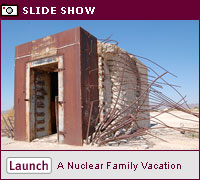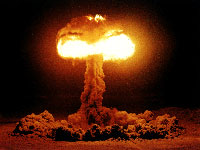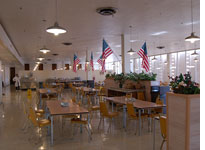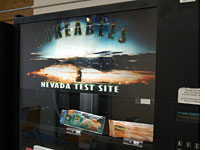A Nuclear Family Vacation
Click here to see a slide show.
On June 24, 1957, the U.S. military touched off a 37-kiloton nuclear device over Frenchman Flat, a dry lake bed about 75 miles northwest of Las Vegas. The atmospheric test, code-named Priscilla, was one in a series called Operation Plumbbob. The provenance of the code name remains obscure; the earliest tests were ordered on the old military alphabet (Able, Baker, Charlie), but several tests in the 1950s were named after women. Test site lore persists that some were named for local prostitutes.
Priscilla, the most powerful of the bombs detonated on Frenchman Flat, was designed to test the effects of a nuclear explosion on construction. The military placed a handful of structures downrange from ground zero, including several buildings, bomb shelters, and even a bank vault built by the Mosler Safe Co.
Was Priscilla beautiful? We only saw the aftermath of the devastation, which was impressive, to say the least.
The blast loosened the trim on the 10-inch-thick safe door and peeled away the steel reinforcing bar from the vault. The explosive force collapsed 6-inch-thick concrete domes, flattened aluminum fallout shelters, and displaced the wall of a windowless brick structure facing ground zero.
Nuclear physicists sometimes hang pictures of their favorite tests above their desks; they can describe, in loving detail, the very personal reasons for their choices. Sometimes it has to do with the limits of a particular design or the start of a new generation of weapons. But for devotees of Priscilla, it was the fireball that impressed them.
Richard Mingus, who started work at the Nevada Test Site during Operation Plumbbob, saw the Priscilla shot from high up in Area 12.
"Oh yes," he recalled. "Priscilla was pretty."
Back in the 1950s, Mingus worked security at the test site, collecting an extra allowance of $25 a week for the commute to Mercury, Nev., a tiny settlement on the southeastern corner of the test range.
At the peak of atomic testing, about 10,000 employees reported to work in Mercury, making the daily trek up Route 95, a highway once known as the "widow-maker"; the government eventually had to expand the treacherous two-lane road into a divided freeway. The last aboveground test at the range—Little Fellar I—was conducted in 1962, a disappointment for Las Vegans who came out to watch. The United States then moved to underground testing. The landscape of Yucca Flat is now dotted with subsidence craters—saucer-shaped formations caused by the vaporization and collapse of rock hundreds of feet underground.
The United States concluded the last full-scale underground test of a nuclear weapon in 1992 and declared an official moratorium in 1994 (the prefabricated towers for Icecap and Gabbs, nuclear tests scheduled for 1993, are still in place).
Today, the site is a shadow of its Cold War self. Unused structures rust away and visitors are warned of mice-borne hantaviruses. About 1,500 people still work there, but much of the site looks like a nuclear ghost town, with loose cables and wires scattered haphazardly across the desert floor. The dated cafeteria looks like what it is: a 1950s holdover, where, until just a few years ago, a steak dinner cost barely a dollar.
But the Nevada Test Site is not just a reliquary for the atomic era, it is also ready, if necessary, to resume nuclear tests. How prepared it should be is at the heart of a current controversy.
The Bush administration wants to boost what is called "test readiness" by shortening the time it takes to prepare for an underground test to 18 months from the current 24 to 36 months. But critics see that as a pretext to resume testing, and Congress has thus far refused to fund anything more than 24-month readiness. Linton Brooks, the head of the National Nuclear Security Administration, noted that the change only involves about $5 million. The issue, he told us, is "high-emotion, low-dollar value."
Work continues today at the Nevada Test Site on "subcritical tests" involving the main components of nuclear weapons. The underground experiments are classified as "high-hazard activities"—an understatement, because they involve putting plutonium and high explosives in close proximity. The work there also involves understanding all the materials—metals, plastics, electronics—that go into a nuclear device.
But a big draw at the Nevada Test Site—and also what brings bus loads of retirees to the place—is the new landscape formed from years of underground tests. Those craters have special meaning to nuclear-weapons designers, according to Ghazar Papazian, who heads the Los Alamos National Laboratory team at the site. The topography of craters is a reflection of a weapons designer's skill, he says.
"You'll see subsidence craters, huge subsidence craters, as huge as can be," he told us before our tour. "That's an indicator of how well it performed. Some of them are as flat as can be."
Those failures (i.e., devices that failed to go off as planned, leaving the surface intact) were a lesson for the designers, Papazian explained: "Gee, I made a mistake. I assumed something; I used a different material that I thought would work. My codes were wrong."
The visitors tour of the test site includes mostly the successes, like the monstrous Sedan crater, excavated by a 104-kiloton device that moved 12 million tons of earth. Sedan was part of the Plowshares project, which sought "peaceful" uses for thermonuclear weapons. Sedan, which was designed to see whether nuclear weapons could be used to dig canals, was a technical success. There was just one minor glitch: The ground proved too radioactive following the explosion.
For outside visitors, however, they rarely show the failures. That's reserved for the designers.
"There were quite a few failures in Nevada," Papazian said.
Part of what goes on at the test site now is old designers taking apprentices to see the failures and explaining what went wrong to learn from those mistakes. "What a humbling experience it is when you go to an event site and it hasn't subsided," Papazian said.
Craters like Priscilla have become a part of the Nevada lore. Impressive dents in the ground were a proof of a designer's mettle. "A designer either became a designer in Nevada or went back to something else," Papazian said. "Because if the design failed, they weren't worth the time they spent designing the system."
Endnote:The National Nuclear Security Administration conducts bus tours of the Nevada Test Site on the last Thursday of every month; there is occasionally a waiting list, so be sure to contact Nevada Site Office's Office of Public Affairs at (702) 295-0944 well in advance of a visit. Photography is not permitted on public days. The Atomic Testing Museum (755 East Flamingo Rd., Las Vegas, Nev.) is just minutes from the Strip. Hours of operation: Monday through Saturday from 9 a.m. to 5 p.m. and on Sunday from 1 p.m. to 5 p.m.



